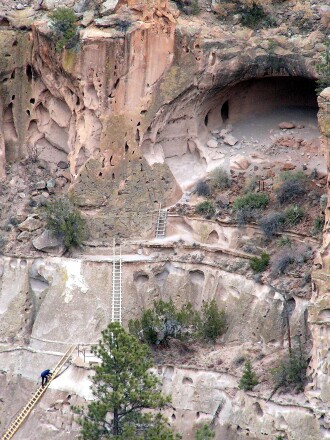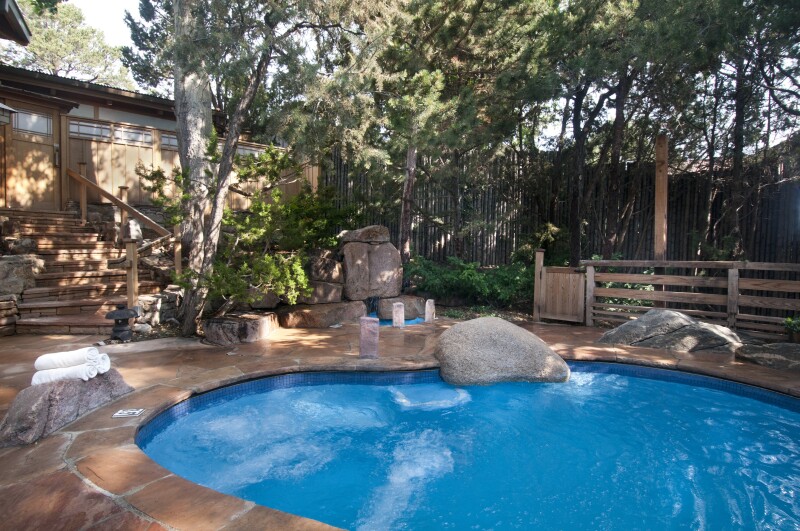There are 15 national parks and monuments across New Mexico. Fifteen! But what’s really cool is that three are in very close proximity to each other—and to Santa Fe—which means you can visit all of them in one easy, beautiful trip.
On a recent long weekend, I plunked myself in art-filled Santa Fe (part of the UNESCO Creative Cities Network) and in between stops at interactive funhouse Meow Wolf, the Georgia O’Keeffe Museum, and other ideas from Afar’s list of the best things to do in Santa Fe, I headed out to explore the state’s special blend of nature and history, perfectly exemplified by the trio of Bandelier National Monument, Valles Caldera National Preserve, and Manhattan Project National Historical Park.
Word to the wise: The next free-entrance national park days are coming up September 28 and November 11, 2024—a good reason to start planning your fall trips now, whether with the family or solo. As if you needed another reason to visit these three national park sites.
Bandelier National Monument

Alcove House, 140 feet up from the floor of Frijoles Canyon, was home to about 25 Ancestral Pueblo people. Today, visitors can climb ladders to see it.
Courtesy of National Park Service
About a 50-minute drive northwest from Santa Fe, Bandelier is 33,000 acres of protected canyonlands and mesas known for well-preserved petroglyphs and cliff dwellings. The 1.4-mile Pueblo Loop Trail begins at the Bandelier National Monument Visitor Center, and it’s not to be missed. It leads you through remnants of ancient Pueblo villages and homes carved into the rocks, some of which you can enter. I was in awe as I climbed; hikers are welcome to ascend wooden ladders into the cool dark cubby holes (called cavates) that date back 500 to 700 years. About halfway through the trail, brave souls with no fear of heights—which rules me out—can opt for a bigger challenge: a series of long, steep ladders that snake a half mile along the side of a cliff to the Alcove House, a large semicircular dwelling 140 feet up from the floor of the canyon. There are many other trails to choose from, including the Falls Trail (which, as the name suggests, delivers you to a waterfall), and the long-haul, 22-mile Painted Cave trek (which also has a pretty self-explanatory name). And there are two campgrounds if you’d like to stay overnight. Check with park rangers before heading out; flood damage over the years has affected trails, and you’ll need the latest safety information.
Note that during peak daily hours of high season (roughly the end of June to mid-October), guests must leave their cars at an external visitor center and board a free shuttle into the park, a program launched to alleviate overcrowded parking lots.
Valles Caldera National Preserve
A 30-minute drive from Bandelier is a completely different type of scenery. This preserve, Valles Caldera, is the result of a volcanic eruption about 1.2 million years ago. The explosion scooped out a 14-mile-wide crater (or caldera) that’s now a flat expanse of grassy meadows (valles in Spanish) surrounded by the Jemez Mountains. The land here has been used by various American Indian tribes for millennia: They hunted, fished, sourced obsidian for tools, and harvested plants for medicine. In the 1800s, the land was taken over by settlers for sheep grazing and cattle ranching. In the early- to mid-1900s, logging decimated the majority of the old-growth forest here. But since 2000, a government trust has focused on preservation and restoration, and today you’ll see grassy prairies, winding rivers, green forests on the volcanic dome, as well as elk, prairie dogs, bald eagles, and black bears among the wildlife. At night, you’ll see the heavens: Valles Caldera is an International Dark Sky Park, and the rangers host night hikes and sky-viewing events during full moons.

All Manhattan Project workers had to go through a security gate to enter the secret city. This is a re-creation of the original.
Photo by Billie Cohen
Manhattan Project National Historical Park
The Manhattan Project National Historical Park is just a 20-minute drive from Bandelier and Valles Caldera (and about 45 from Santa Fe), and once you’ve seen the other two parks (and even if you haven’t), it’ll quickly become clear why the U.S. government put Los Alamos where they put it. If it was the 1940s and you were looking for a secret, isolated spot to build a highly classified project like the atomic bomb, this swath of lonely, scrubby land surrounded by mountains was the place to do it.
The park is actually made up of three separate sites spread across the country: a former plutonium factory in Hanford, Washington; a former uranium-enriching complex in Oak Ridge, Tennessee, and the old research and lab complex in Los Alamos, New Mexico. The Los Alamos arm is often referred to as “Atomic City,” but it’s more like a college campus, and visitors can spend a full day wandering among historic buildings and museums.
Touring the campus is enlightening, but it’s also uncomfortable and incongruous. Bad things were created here. But then, so were 80 babies, in 1943 alone. By the visitor center, I rested in a gazebo overlooking a small, picturesque lake. I watched tourists pose for jokey selfies with a life-size bronze statue of Manhattan Project leaders Oppenheimer and General Groves. The history museum gift shop sells key chains and stickers printed with Oppenheimer’s pipe-smoking profile.
The chance to walk through history, though, is invaluable. The Bradbury Science Museum and the Los Alamos History Museum recount the bomb project from its beginnings through its aftermath (including spy stories, relics from tests, and replicas of the Little Boy and Fat Man atomic bombs). But I was most intrigued by all the information about everyday life described throughout the campus’s historic buildings on plaques and displays: the cottages where scientists and civilians lived, how phone calls were secured, the dinner soirees and wild dorm parties, the fact that Sears, Roebuck & Company complained about sending 400 catalogs to a single P.O. Box (because little did they know that all civilians who lived here shared the same address, for security purposes).
And if you’d like to walk through movie history, you can do that too. Oppenheimer was made here in 2022, and the National Park Service created a self-guided tour of filming locations via paper pamphlet or the NPS app.
For those wanting to know more about the scientific history side of things, nab a spot on the rare and popular “behind the fence” tours of the Los Alamos National Laboratory. Held only a few times a year, they take guests to infamous spots including Pond Cabin, where Emilio Segrè’s plutonium research team worked, and the Battleship Bunker, where scientists studied magnetic field disruptions and implosions.

Ten Thousand Waves hotel opened as a small bathhouse complex in 1981. Today it still has that Japanese onsen vibe.
Courtesy of Ten Thousand Waves
Where to stay in Santa Fe
- The long-standing Inn of the Five Graces, a Relais & Châteaux family-owned hotel, added an excellent spa in 2021. Like the rest of the hotel, its design features textiles and furnishings imported by the owners from such places as India, Afghanistan, and Morocco, as well as detailed tile mosaics in the bathroom and treatment rooms.
- The art-filled, historic La Fonda Hotel was an R&R escape for those sequestered at Los Alamos (and is still a top getaway for visitors). Even if you don’t stay here, make time for a cocktail at its Bell Tower Rooftop Bar.
- The serene 20-acre, Japanese-styled Ten Thousand Waves is nestled in the high hills among Santa Fe’s piñons and junipers about a 15-minute drive from downtown. Splurge on the spa’s deep stone massage and salt scrubs, or opt for a warming herbal wrap with an add-on foot soak. The spa is open to nonguests, as is the worth-the-trip Izanami, which serves izakaya-style food using sustainably raised beef, pork, chicken, and organic vegetables.











